Sony Trinitron KV-32FQ80, Trinitron KV-36FQ80, Trinitron KV-36FQ80U, Trinitron KV-32FQ80U User Manual
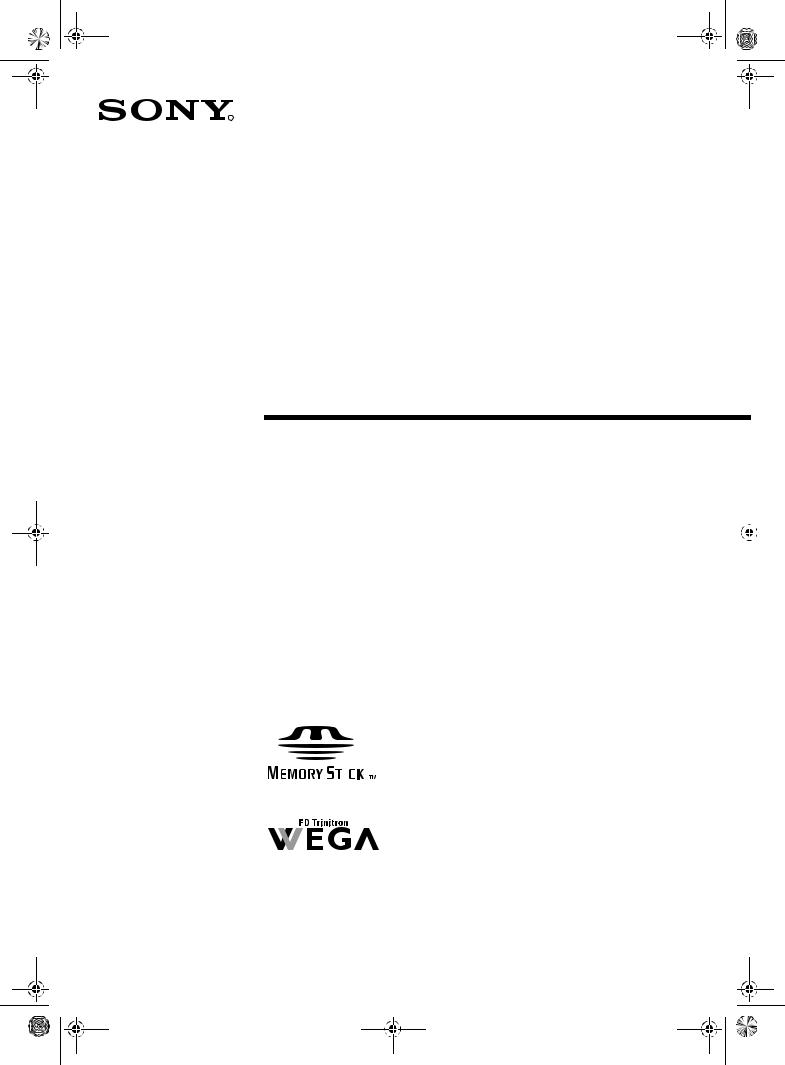
32FQ80 B5 U(00) Cover.fm Page 1 Thursday, May 9, 2002 12:35 PM
4-087-551-61(1)
R
Trinitron Colour
Television
Operating Instructions |
|
GB |
|
|
|
|
|
|
|
|
|
|
|
|
|
|
|
|
|
|
|
|
|
|
|
|
|
|
|
|
|
|
|
|
|
|
|
|
|
|
|
|
|
|
|
|
|
|
KV-32FQ80U
KV-36FQ80U
© 2002 Sony Corporation
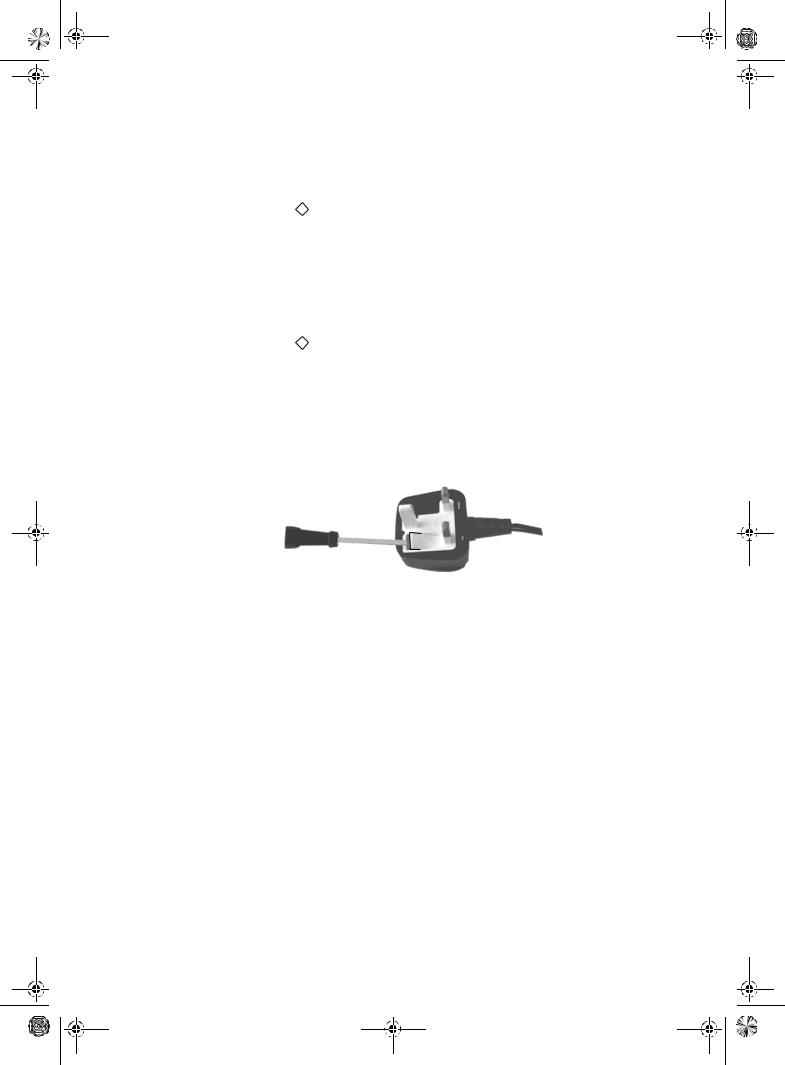
32FQ80 B5 U(00) Cover.fm Page 2 Thursday, May 9, 2002 12:35 PM
NOTICE FOR CUSTOMERS IN THE UNITED KINGDOM For KV-32FQ80U models
A moulded plug complying with BS1363 is fitted to this equipment for your safety and convenience. Should the fuse in the plug supplied need to be replaced, a 5 AMP fuse approved by ASTA or BSI to BS 1362 (i.e. marked with ASAT or  ) must be used. When an alternative type of plug is used it should be fitted with a 5 AMP fuse, otherwise the circuit should be protected by a 5 AMP fuse at the distribution board. If the plug supplied with this equipment has a detachable fuse cover, be sure to attach the fuse cover after you change the fuse. Never use the plug without the fuse cover. If you should lose the fuse cover, please contact your nearest Sony service centre.
) must be used. When an alternative type of plug is used it should be fitted with a 5 AMP fuse, otherwise the circuit should be protected by a 5 AMP fuse at the distribution board. If the plug supplied with this equipment has a detachable fuse cover, be sure to attach the fuse cover after you change the fuse. Never use the plug without the fuse cover. If you should lose the fuse cover, please contact your nearest Sony service centre.
For KV-36FQ80U models
A moulded plug complying with BS1363 is fitted to this equipment for your safety and convenience. Should the fuse in the plug supplied need to be replaced, a 13 AMP fuse approved by ASTA or BSI to BS 1362 (i.e. marked with ASAT or  ) must be used. When an alternative type of plug is used it should be fitted with a 13 AMP Fuse, otherwise the circuit should be protected by a 13 AMP fuse at the distribution board. If the plug supplied with this equipment has a detachable fuse cover, be sure to attach the fuse cover after you change the fuse. Never use the plug without the fuse cover. If you should lose the fuse cover, please contact your nearest Sony service centre.
) must be used. When an alternative type of plug is used it should be fitted with a 13 AMP Fuse, otherwise the circuit should be protected by a 13 AMP fuse at the distribution board. If the plug supplied with this equipment has a detachable fuse cover, be sure to attach the fuse cover after you change the fuse. Never use the plug without the fuse cover. If you should lose the fuse cover, please contact your nearest Sony service centre.
How to replace the Fuse
Open the fuse compartment with a flat blade screwdriver, and replace the fuse.
FUSE
IMPORTANT
If the plug supplied is not suitable for the socket outlet in your home, it should be cut off and an appropriate plug fitted in accordance with the following instructions:
The wires in this mains lead are coloured in accordance with the following code: Blue: Neutral
Brown: Live
As the colours of the wires in the mains lead of this apparatus may not correspond with the coloured markings identifying the terminals in your plug, proceed as follows:
The wire which is coloured blue must be connected to the terminal which is marked with the letter N or coloured black. The wire which is coloured brown must be connected to the terminal which is marked with the letter L or coloured red. Do not connect either wire to the earth terminal in the plug which is marked by the letter E or by the safety earth symbol I or coloured green or green and yellow.
WARNING
•To prevent shock hazard, do not insert the plug cut off from the mains lead into a socket outlet. This plug cannot be used and should be destroyed.
•To prevent fire or shock hazard, do not expose the unit to rain or moisture.
•Dangerously high voltages are present inside the set. Do not open the cabinet. Refer servicing to qualified personnel only.
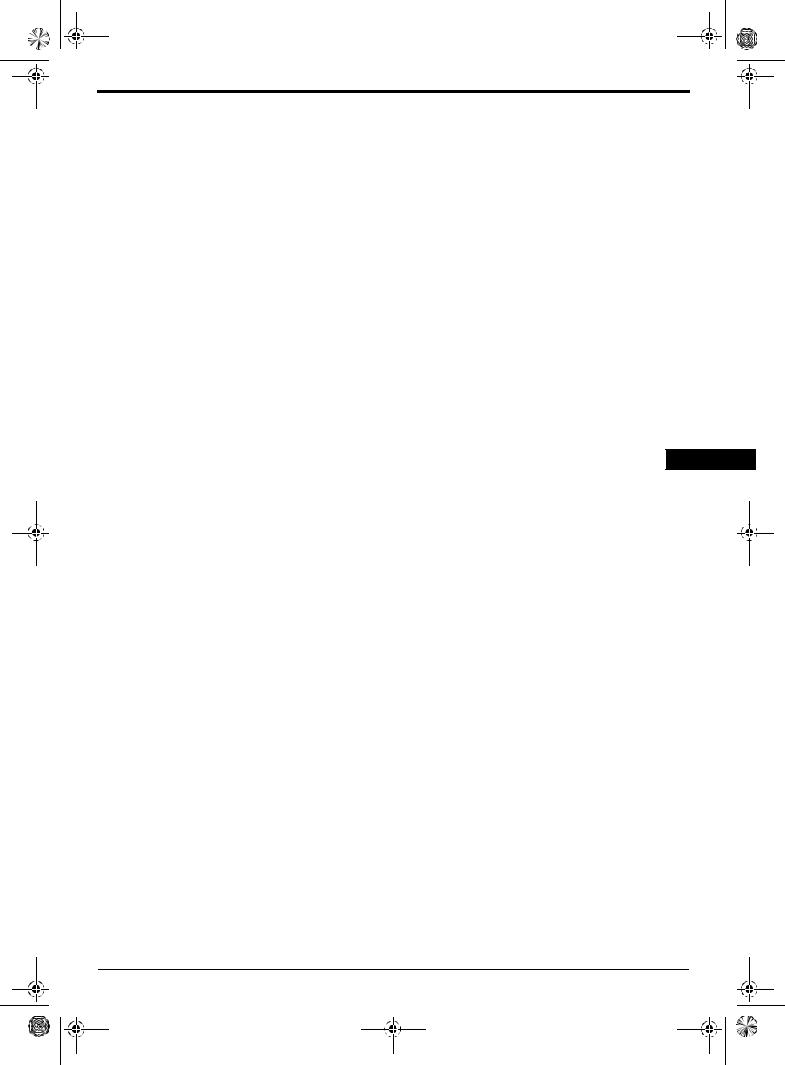
32FQ80 B5 Part 1.fm Page 1 Tuesday, May 28, 2002 1:00 PM
GB
1
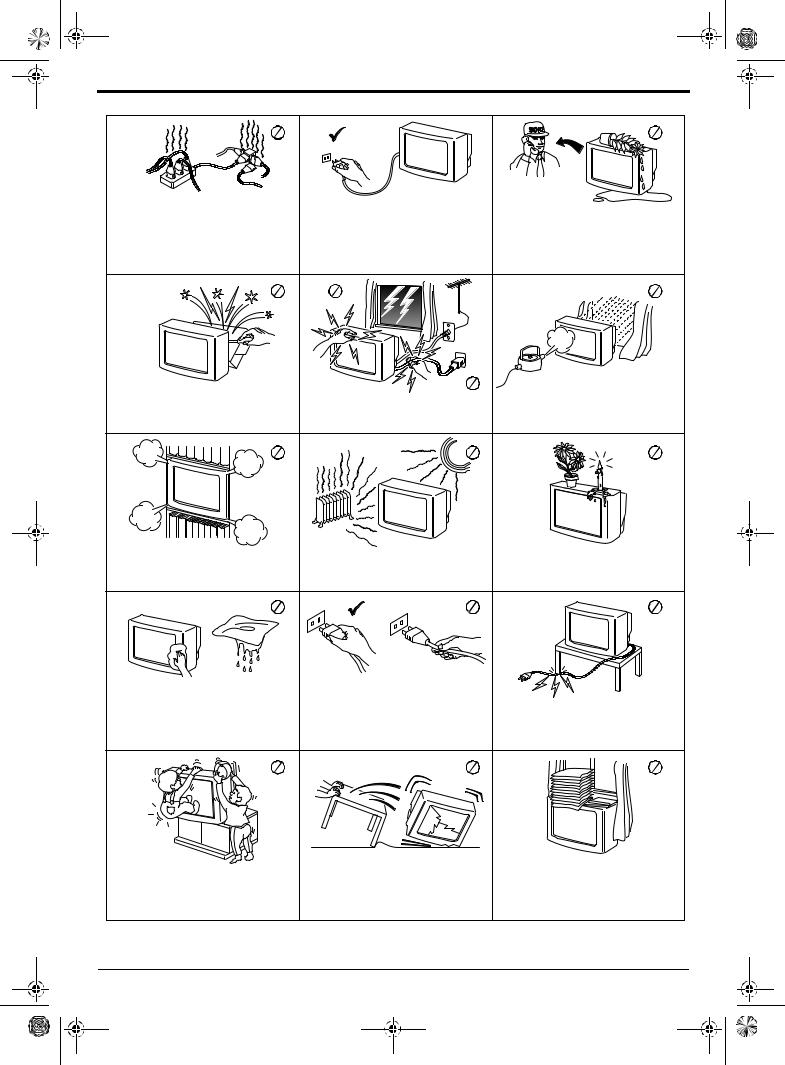
32FQ80 B5 Part 1.fm Page 2 Tuesday, May 28, 2002 1:00 PM
This set is to operate on a 220-240V AC supply only. Take care not to connect too many appliances to the same power socket as this could result in fire or electric shock.
For environmental and safety reasons, it is recommended that the TV set is not left in standby mode when not in use. Disconnect from the mains.
Never push objects of any kind into the set as this could result in a fire or electric shock. Never spill liquid of any kind on the set. If any liquid or solid object does fall through, do not operate the TV. Have it checked immediately by qualified personnel.
Do not open the cabinet and the rear cover of the TV. Refer to qualified service personnel only.
For your own safety, do not touch any part of the TV, power lead or aerial lead during lightning storms.
To prevent fire or shock hazard, do not expose the TV to rain or moisture.
Do not cover the ventilation openings of the TV. For ventilation, leave a space of at least 10cm all around the set.
Never place the TV in hot, humid or excessively dusty places. Do not install the TV where it may be exposed to mechanical vibrations.
To prevent fire, keep inflammable objects or naked lights (eg candles) away from the TV.
Clean the TV with a soft, lightly dampened cloth. Do not use benzine, thinner or any other chemicals to clean the TV. Do not scratch the TV screen. As a safety precaution, unplug the TV before cleaning it.
Pull out the power lead by the plug. Do not pull on the power lead itself.
Take care not to place heavy objects on the power lead as this could result in damage. We recommend you wind any excess lead around the holders provided on the rear of the TV.
Place the TV on a secure stable stand. Do not allow children to climb on to it. Do not place the TV on its side or face up.
Unplug the power lead before moving the TV. Avoid uneven surfaces, quick steps or excessive force. If the set has been dropped or damaged, have it checked immediately by qualified service personnel.
Do not cover the ventilation openings of the TV with items such as curtains or newspapers etc.
Note: Due to the unique floating design of this TV, Sony highly recommend you use their designated stand SU/32FQ2 for KV-32FQ80 and SU/36FQ2 for KV-36FQ80.
2 Safety Information
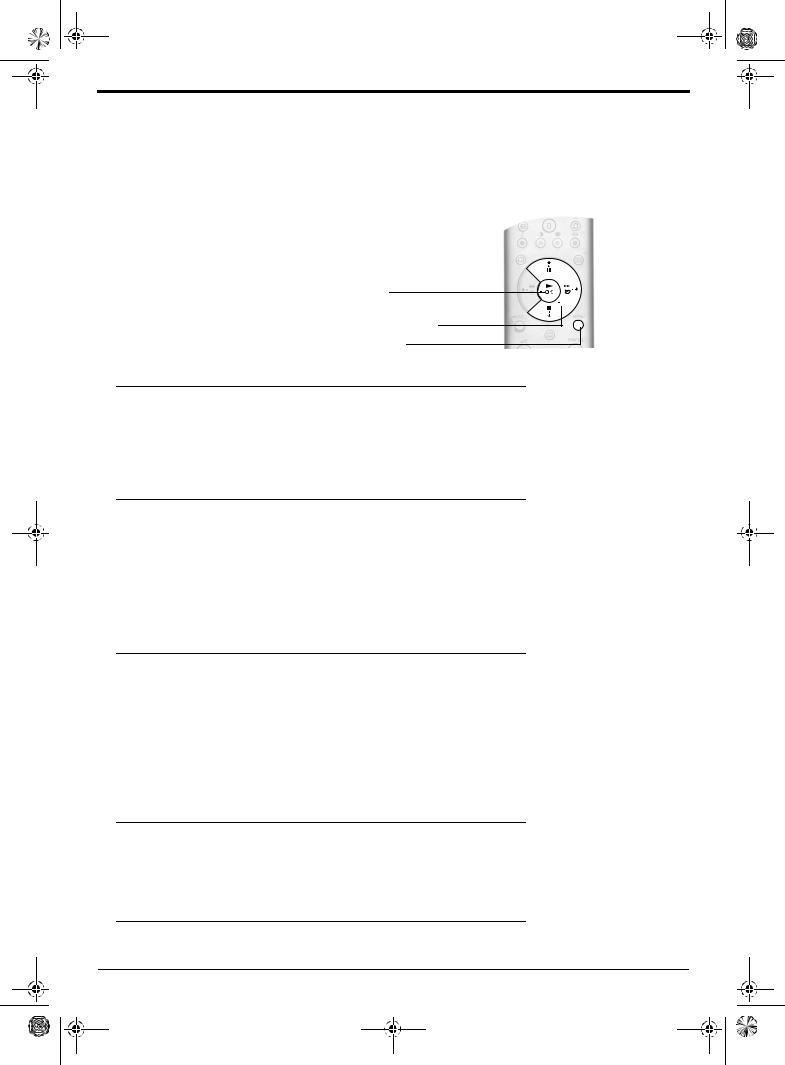
32FQ80 B5 Part 1.fm Page 3 Tuesday, May 28, 2002 1:00 PM
Thank you for choosing this Sony Trinitron Television.
Before operating this TV, please read this instruction manual thoroughly and retain it for future reference.
Throughout this instruction manual there are illustrations of the remote control with certain buttons shaded white.
This shading indicates the buttons you will need to press when following the instructions.
For example, the illustration on the right shows that the
MENU, V, v, b and OK buttons will need to be pressed.
OK button
V, v and b buttons
MENU button
Getting Started
Checking the supplied accessories. . . . . . . . . . . . . . . . . . . . . . . . . . . . . . . . 4
Inserting batteries into the remote control. . . . . . . . . . . . . . . . . . . . . . . . . . . 4
Connecting an aerial and VCR . . . . . . . . . . . . . . . . . . . . . . . . . . . . . . . . . . . 5
Switching on the TV . . . . . . . . . . . . . . . . . . . . . . . . . . . . . . . . . . . . . . . . . . . 5
Automatically tuning the TV . . . . . . . . . . . . . . . . . . . . . . . . . . . . . . . . . . . . . 6
Basic Operation
Overview of the remote control . . . . . . . . . . . . . . . . . . . . . . . . . . . . . . . . . . 7
Overview of the TV buttons. . . . . . . . . . . . . . . . . . . . . . . . . . . . . . . . . . . . . . 8
Text . . . . . . . . . . . . . . . . . . . . . . . . . . . . . . . . . . . . . . . . . . . . . . . . . . . . . . . . 9
Multi Picture In Picture (Multi PIP) . . . . . . . . . . . . . . . . . . . . . . . . . . . . . . . . 11
Picture And Picture (PAP). . . . . . . . . . . . . . . . . . . . . . . . . . . . . . . . . . . . . . . 11
The Programme Index Table . . . . . . . . . . . . . . . . . . . . . . . . . . . . . . . . . . . . 12
Screen Mode. . . . . . . . . . . . . . . . . . . . . . . . . . . . . . . . . . . . . . . . . . . . . . . . . 12
NexTView Electronic Programme Guide (EPG) . . . . . . . . . . . . . . . . . . . . . . 13
Advanced Operation
Using the TV menu system. . . . . . . . . . . . . . . . . . . . . . . . . . . . . . . . . . . . . . 15
Picture Adjustment menu . . . . . . . . . . . . . . . . . . . . . . . . . . . . . . . . . . 15
Sound Adjustment menu . . . . . . . . . . . . . . . . . . . . . . . . . . . . . . . . . . . 16
Features menu . . . . . . . . . . . . . . . . . . . . . . . . . . . . . . . . . . . . . . . . . . 17
Set Up menu . . . . . . . . . . . . . . . . . . . . . . . . . . . . . . . . . . . . . . . . . . . . 17
Manual Set Up menu. . . . . . . . . . . . . . . . . . . . . . . . . . . . . . . . . . . . . . 18
Manual Programme Preset menu . . . . . . . . . . . . . . . . . . . . . . . . . . . . 19
Further Programme Preset menu . . . . . . . . . . . . . . . . . . . . . . . . . . . . 20
Viewing Memory Stick pictures . . . . . . . . . . . . . . . . . . . . . . . . . . . . . . . . . . . 21
Additional Information
Connecting other equipment to the TV . . . . . . . . . . . . . . . . . . . . . . . . . . . . . 25
Remote control of other equipment. . . . . . . . . . . . . . . . . . . . . . . . . . . . . . . . 27
Specifications . . . . . . . . . . . . . . . . . . . . . . . . . . . . . . . . . . . . . . . . . . . . . . . . 28
Troubleshooting . . . . . . . . . . . . . . . . . . . . . . . . . . . . . . . . . . . . . . . . . . . . . . 28
Table of Contents 3
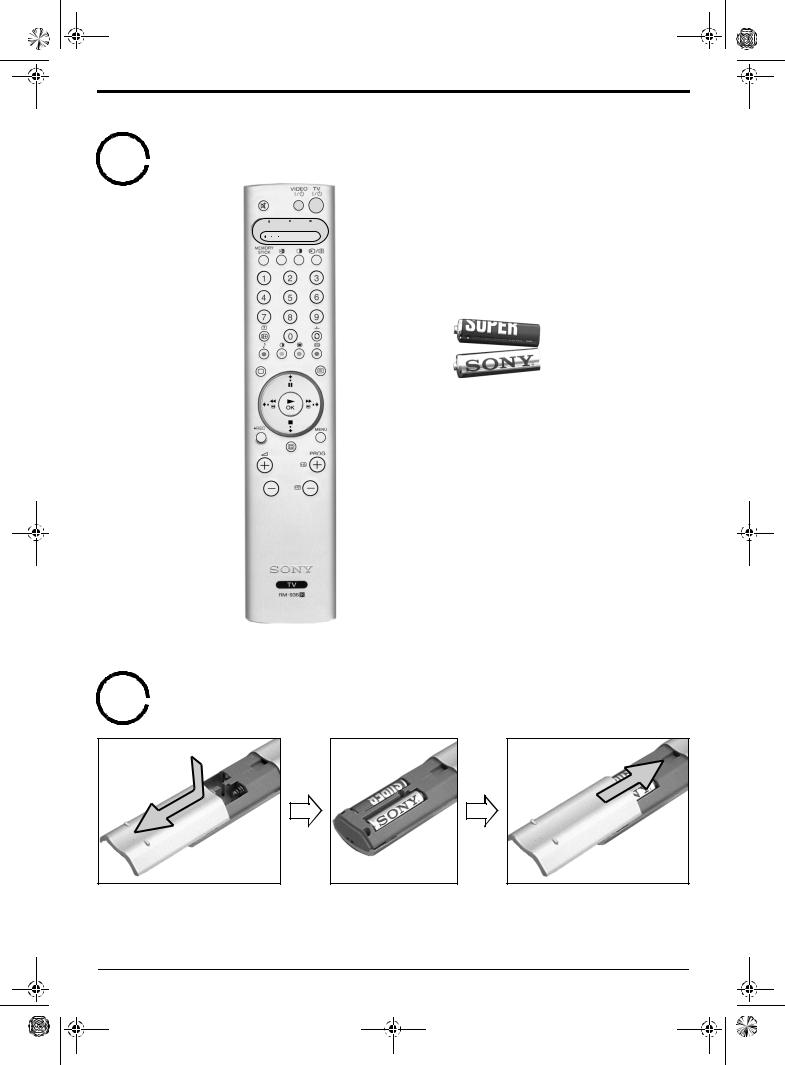
32FQ80 B5 Part 1.fm Page 4 Tuesday, May 28, 2002 1:00 PM
Follow steps 1 - 5 to install the TV and view programmes.
1  Checking the supplied accessories
Checking the supplied accessories
VCR TV DVD
MODE 


Batteries
Remote control
2  Inserting batteries into the remote control
Inserting batteries into the remote control
Always remember to:
•observe the correct polarity when inserting batteries,
•dispose of batteries in an environmentally friendly way.
4 Getting Started

32FQ80 B5 Part 2.fm Page 5 Tuesday, May 28, 2002 1:03 PM
3  Connecting an aerial and VCR
Connecting an aerial and VCR
Connecting an aerial only
1. Connect your aerial lead to the aerial socket labelled 
 on the rear of the TV.
on the rear of the TV.
 4
4 s 4
s 4
(SMARTLINK)
 3
3 s 3
s 3
VCR
 2
2
DVD
 1
1
ANALOGUE
R/D/D/D L/G/S/I
DOLBY.THE DOUBLE-D SYMBOL DD
ARE TRADEMARKS OF DOLBY
LABORATORIES
Connecting an aerial and VCR
 4
4 s 4
s 4
 3
3 s 3
s 3
VCR
 2
2
DVD
 1
1
R/D/D/D L/G/S/I
DOLBY.THE DOUBLE-D SYMBOL DD
ARE TRADEMARKS OF DOLBY
LABORATORIES
RF lead  (not supplied)
(not supplied)
Scart lead (not supplied)
1. Connect your aerial lead to the IN* socket on your VCR.
2. Connect an RF lead from the OUT* socket on your VCR to the aerial socket labelled 
 on the rear of the TV.
on the rear of the TV.
3. |
Connect a fully wired 21-pin scart lead from the |
|||
|
scart socket marked |
3/ |
|
s 3 on the rear of the |
|
|
|||
TV to a scart socket on your VCR**
Notes: *Socket names may vary depending on make and model of VCR. Refer to your VCR instruction manual for details.
**If your VCR does not have a scart socket follow the connecting instructions above ignoring the scart lead connection.
You will also need to manually tune the VCR to a spare TV channel (ideally channel 0, refer to the ‘Manual Programme Preset menu’ section of this instruction manual).
VCR
4  Switching on the TV
Switching on the TV
1. Connect the TV plug to your mains socket
(220 - 240V AC, 50 Hz).
2. The TV is usually switched on. If not, push in the On/Off button  on the front of the TV.
on the front of the TV.
If the red standby mode indicator on the front of the TV is lit, press the TV / button on the remote control to switch on the TV set. Please be patient as the picture may take a few moments to appear on the TV screen.
button on the remote control to switch on the TV set. Please be patient as the picture may take a few moments to appear on the TV screen.
Getting Started 5
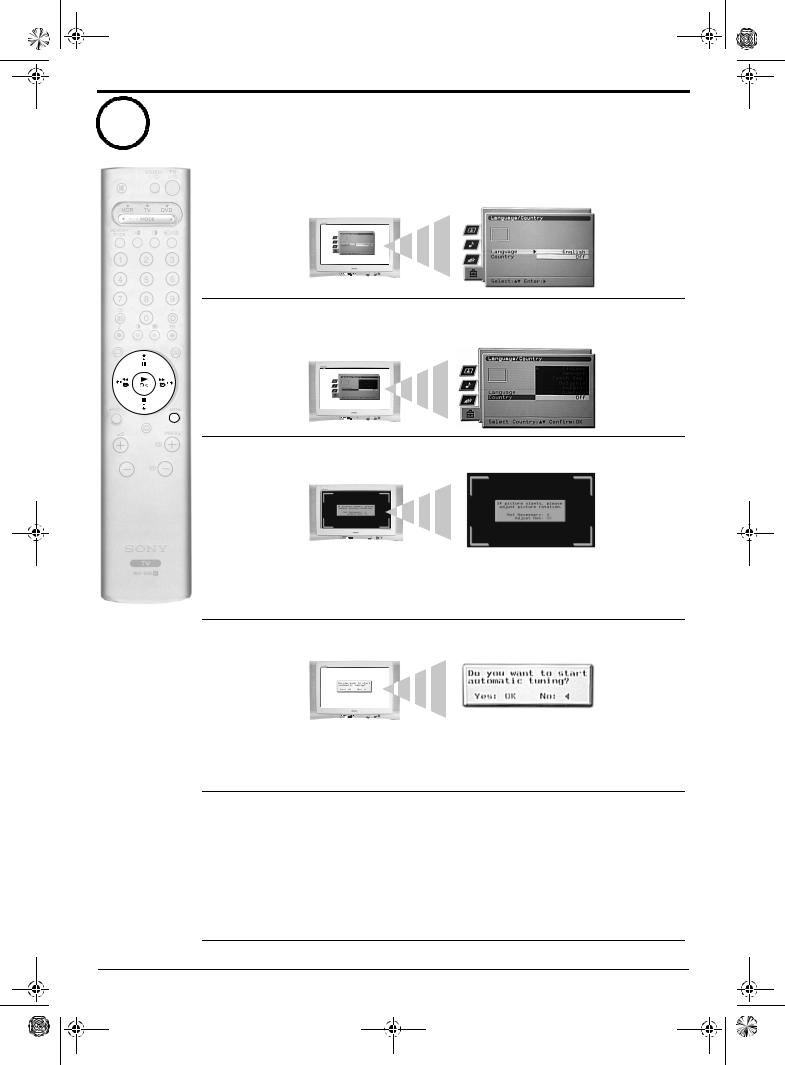
32FQ80 B5 Part 2.fm Page 6 Tuesday, May 28, 2002 1:03 PM
5 Automatically tuning the TV
1. When you switch on the TV for the first time the Sony logo appears on the TV screen, followed by the Memory Stick logo, and then by the Language/Country menu with the word ‘English’ highlighted. Press the V or v buttons on the remote control to highlight your required language. Press the OK button to confirm your choice. From now on all menus appear in your chosen language.
2. |
The word ‘Country’ is now highlighted. Press the V or v buttons to highlight the country |
|
in which you are using the TV. It is important to select the correct country to ensure |
correct Teletext displays. Press the OK button to confirm your choice.
MENU
3. The picture rotation prompt appears. Sometimes the Earth’s natural magnetism can cause the screen to look tilted.
a)If no correction is required, press the B button on the remote control.
b)If some correction is required, press the OK button on the remote control. Press the V or v buttons to rotate the picture over a range of -5 to +5. Press the OK button to store.
4.The autotune prompt screen appears. Press the OK button to select Yes. The autotune procedure begins, tuning in all the available channels.
A display appears on the TV screen to inform you of the tuning progress.
If no channels are found, a display appears on the TV screen asking you to confirm your aerial is connected. Check the aerial has been connected correctly then press the OK button to repeat the tuning process.
5. Once all available channels have been tuned in, the ‘Programme Sorting’ menu appears. This menu allows you to rearrange the order of the channels on the TV.
a)If you do not wish to rearrange the order, press the MENU button to remove the ‘Programme Sorting’ menu from the TV screen.
b)If you wish to rearrange the order, press the V or v buttons to select the channel you wish to move, then press the b button. Press the V or v buttons to select the new position for your selected channel. Press the OK button to confirm. The selected channel moves to its new position. Repeat this procedure if you wish to move other channels. Press the MENU button to remove the ‘Programme Sorting’ menu from the TV screen when you have finished rearranging the channel order.
The TV has now tuned in all the available channels and is ready for use.
6 Getting Started
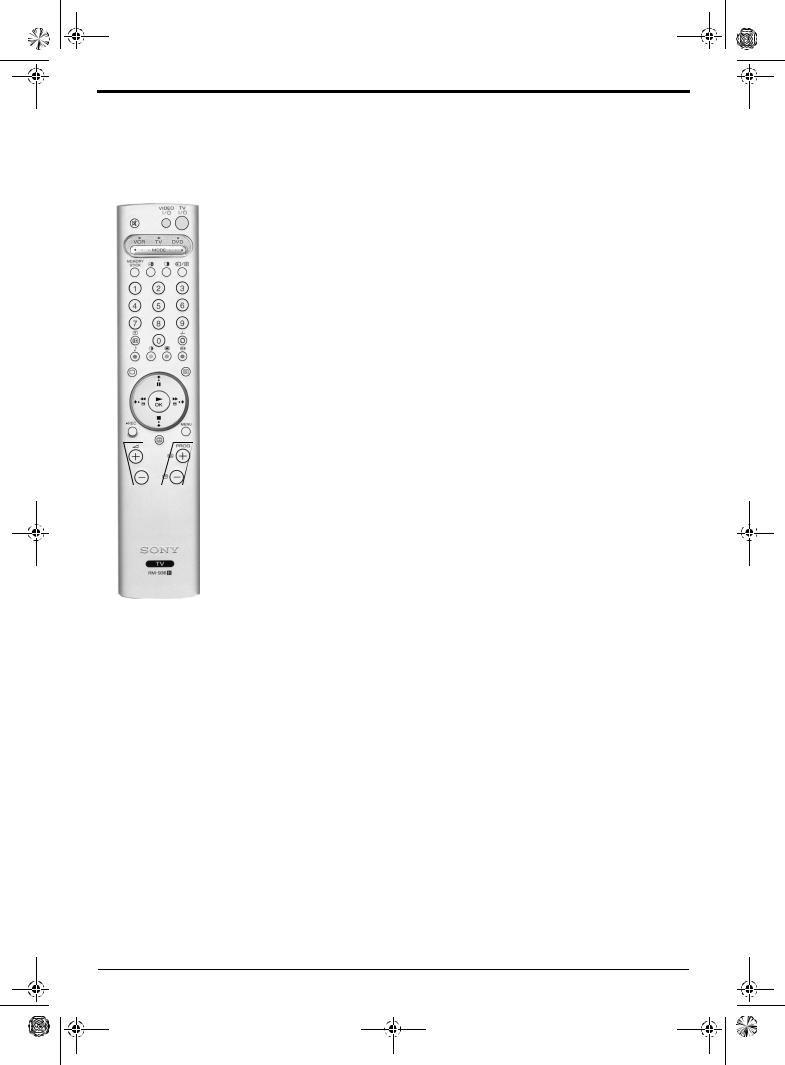
32FQ80 B5 Part 2.fm Page 7 Monday, September 30, 2002 8:19 AM
Overview of the remote control
1 |
|
2 3 |
|
|
|
|
|
|
|||||||||
4 |
|
|
|
|
|
|
|
|
|
|
|
|
|
|
|
qh |
|
|
|
|
|
|
|
|
|
|
|
|
|
|
|
|
|||
|
|
|
|
|
|
|
|
|
|
|
|
|
|
|
|||
|
|
|
|
|
|
|
|
|
|
|
|
|
|
|
|||
5 |
|
|
|
|
|
|
|
|
|
|
|
|
|
|
|
||
|
|
|
|
|
|
|
|
|
|
|
|
|
|
|
|||
|
|
|
|
|
|
|
|
|
|
|
|
|
|
|
|||
6 |
|
|
|
|
|
|
|
|
|
|
|
|
|
|
|
qj |
|
|
|
|
|
|
|
|
|
|
|
|
|
||||||
7 |
|
|
|
|
|
|
|
|
|
|
|
|
|
|
|
|
qk |
|
|
|
|
|
|
|
|
|
|
|
|
|
|
|
|
||
8 |
|
|
|
|
|
|
|
|
|
|
|
|
|
|
|||
|
|
|
|
|
|
|
|
|
|
|
|
|
|
||||
9 |
|
|
|
|
|
|
|
|
|
|
|
|
|
|
|
ql |
|
|
|
|
|
|
|
|
|
|
|
|
|
|
|
||||
|
|
|
|
|
|
|
|
|
|
|
|
|
|
||||
|
|
|
|
|
|
|
|
|
|
|
|
|
|||||
q; |
|
|
|
|
|
|
|
|
|
|
|
|
|
|
|
w; |
|
|
|
|
|
|
|
|
|
|
|
|
|
|
|
||||
|
|
|
|
|
|
|
|
|
|||||||||
qa |
|
|
|
|
|
|
|
|
|
|
|
|
|
|
wa |
||
|
|
|
|
|
|
|
|
|
|
|
|
|
|
||||
|
|
|
|
|
|
|
|
|
|
|
|
|
|
||||
qs |
|
|
|
|
|
|
|
|
|
|
|
|
|
|
|
|
|
|
|
|
|
|
|
|
|
|
|
|
|
|
|
||||
qd |
|
|
|
|
|
|
|
|
|
|
|
|
ws |
||||
|
|
|
|
|
|
|
|
|
|||||||||
qf |
|
|
|
|
|
|
|
|
|
|
|
wd |
|||||
|
|
|
|
|
|
|
|
|
|
|
|
|
|||||
|
|
|
|
|
|
|
|
|
|||||||||
qg |
|
|
|
|
|
|
|
|
|
|
|
|
|||||
|
|
|
|
|
|
|
|
|
|
|
|
||||||
1Mute button
Press to mute the TV sound. Press again to restore the sound.
2VIDEO Standby button
Press to switch off your VCR or DVD temporarily.
3TV Standby button
Press to switch off your TV temporarily. The standby indicator on the front of the TV is lit. Press again to return to normal operation.
4b MODE B button
This remote can also operate other equipment. Refer to ‘Remote control of other equipment’ for details.
5PAP Swap button
Press to swap screens in Picture And Picture (PAP) mode. Refer to ‘Picture And Picture (PAP)’ for details.
6MEMORY STICK button
Press to display the ‘Memory Stick’ menu. Refer to the ‘Viewing Memory Stick pictures’ section of this manual for details.
7Numbered buttons
When the b MODE B button is set to VCR or TV, press to input the required channel number. For two digit channel numbers, enter the second digit within two seconds.
8Info/Reveal button
In TV Mode: Press to reveal on screen information such as channel number etc. In Text Mode: Press to reveal concealed information (e.g. answers to a quiz). Press again to cancel.
9Picture Mode button
Press repeatedly to change the ‘Picture Mode’ then press the OK button to confirm your selection. Refer to the ‘Picture Adjustment’ menu for details.
q; Sound Mode button
Press to repeatedly change the ‘Sound Mode’ then press the OK button to confirm. Refer to the ‘Sound Adjustment’ menu .
qa TV button
Press to return to normal TV operation from Text or Video Input mode.
qs Control Pad and OK button
When in the TV menu system, press the control pad buttons to move through the options in each display. Press the OK button to confirm a selection.
Note: When the b MODE B button is set to VCR or DVD the control pad and OK buttons operate the main functions of your VCR or DVD.
qd REC button
When the b MODE B button is set to VCR, press this button to begin recording.
qf Volume buttons
Press to increase (+) or decrease (-) the volume.
qg EPG button
Press to display the Electronic Programme Guide. Refer to ‘NexTView Electronic Programme Guide (EPG)’ for details.
qh PAP button
Press to enter Picture And Picture (PAP) mode. Refer to ‘Picture And Picture (PAP)’ for details.
qj Input Select/Hold button
In TV Mode: Press to select signals from equipment connected to the TV sockets (refer to ‘Connecting additional equipment’ for details).
In Text Mode: Press to hold the current page. Press again to cancel.
qk Channel Return button
Press to return to the previous channel you were watching (provided you watched it for at least 5 seconds).
Note: If the b MODE B button is set to VCR you can use this button to select double digit channel numbers, e.g. press the 
 button then press 2 and 3 for channel 23.
button then press 2 and 3 for channel 23.
ql Multi PIP button
Press to enter Multi Picture In Picture (Multi PIP) mode. Refer to ‘Multi Picture In Picture (Multi PIP)’ for details.
w; Screen Mode button
Press repeatedly to change the screen mode. Refer to ‘Screen Mode’ for details.
wa Text button
Press to switch Text on or off. Refer to the ‘Text’ section for details.
ws Menu button
Press to enter the menu system of this TV. Refer to ‘Using the TV menu system’ for details.
wd Programme buttons
In TV Mode: Press to display the next (+) or previous (-) channel.
In Text Mode: Press to select the next (+) or previous (-) Text page.
Coloured buttons
The ‘Picture Mode’, ‘Sound Mode’, ‘Multi Picture In Picture (Multi PIP)’ and ‘Screen Mode’ buttons can also be used as Fastext buttons. Refer to the ‘Text’ section for details.
Basic Operation 7

32FQ80 B5 Part 2.fm Page 8 Tuesday, May 28, 2002 1:03 PM
Overview of the TV buttons
Accessing the control panel
The TV buttons can be found on the control panel on the front of the TV.
MONO
L/G/S/I R/D/D/D
MEMORY STICK |
S 5 |
5 |
5 |
+ |
P + |
Auto Start up button
Press to start the auto start up sequence.
Video input button
Press to select signals from equipment connected to the TV sockets (refer to ‘Connecting other equipment to the TV’ for details).
Volume buttons
Press to increase (+) or decrease (-) the volume.
Programme buttons
Press to display the next
(+) or previous (-) channel.
Note: For information on the front panel connectors, refer to ‘Connecting other equipment to the TV’.
8 Basic Operation
